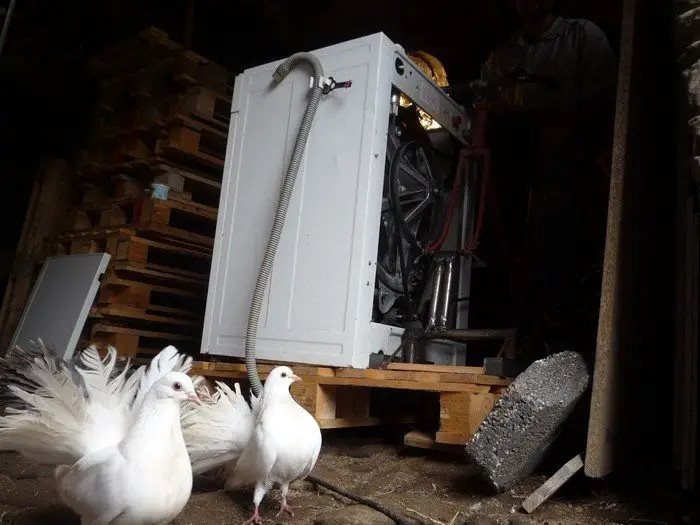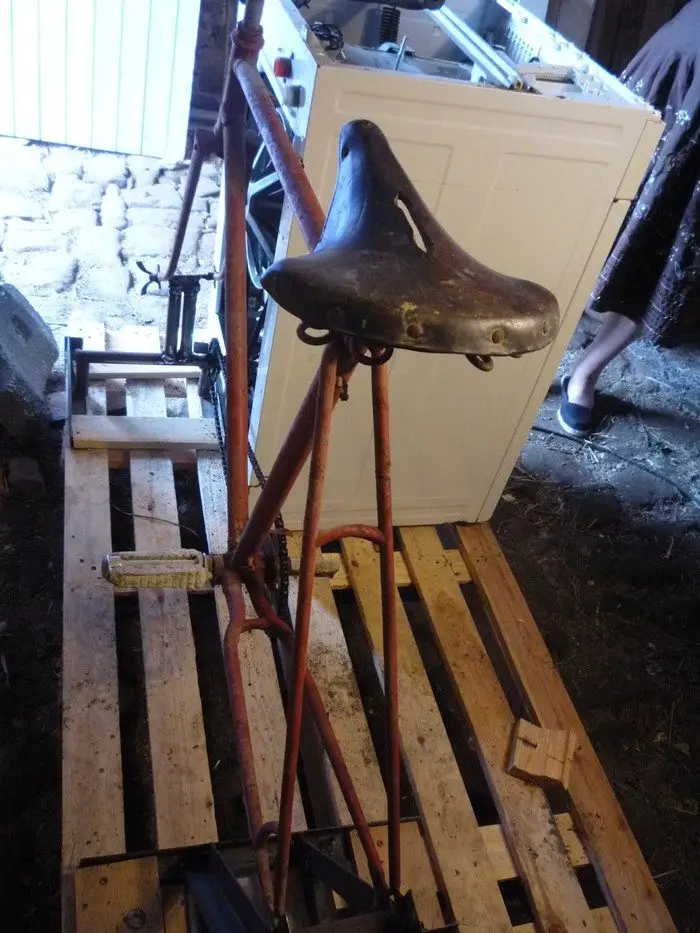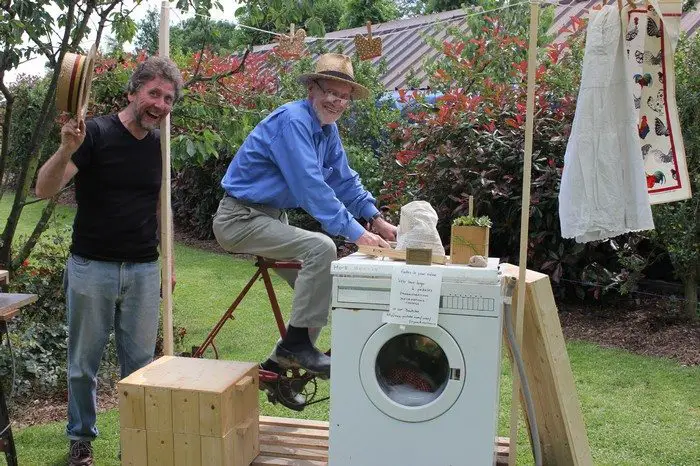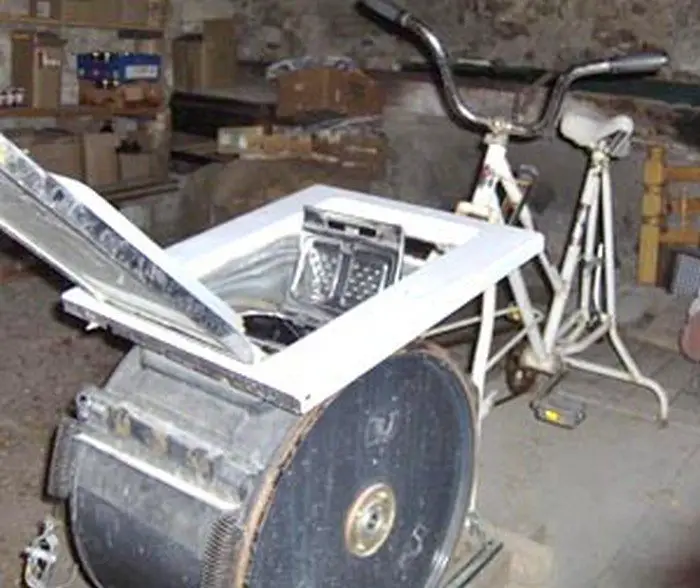If you’re dreaming of going off-grid, or you just want a fun project, this is for you! All you need is a failed, irreparable electric washing machine and an old bike! You now have a pedal-powered electric washing machine!

Nope – it’s not about upcycling or repurposing. It’s about turning an electric appliance into one that is human powered! This project may depend on the type of defect you have with your washing machine but you can basically do it by hooking it up with a bicycle.
By converting your electric appliance into a pedal-powered electric washing machine you save on electricity and water while helping the environment and yourself as you exercise yourself to a healthier life. Get the family ‘on their bike’ until the load is done :)
It can even help you minimise your total water consumption since you are the one running the machine. You can reuse water from your laundry to water your plants, clean your backyard or your car.
Learn all about how this electric washing machine was made human-powered by heading over to the article linked below.
Is this a better idea than buying a new washing machine for you?
Building a Pedal-Powered Electric Washing Machine
Materials
- Used Bicycle
- Timber
- Timber Pallet
- Steel Frames
- 10mm Nuts
Tools
- Welding Machine
- Angle Grinder
- Cordless Drill
- Saw
Instructions
Step 1: Prepare the Frame
- Use the saw to cut the timber and timber pallet to the required dimensions to create a frame that will support the washing machine drum and the bicycle.
- Ensure the frame is sturdy enough to hold the components securely.
Step 2: Modify the Bicycle
- Remove the rear wheel of the used bicycle.
- Use the angle grinder to make adjustments to the bicycle frame if necessary, so it can integrate with the washing machine drum.
Step 3: Assemble the Drive Mechanism
- Mount the bicycle to the timber frame so that the chain or belt can be attached to the washing machine drum.
- Position the bicycle so that when pedaled, it will turn the drum.
Step 4: Prepare the Washing Machine Drum
- Extract the drum from the old electric washing machine.
- Using the welding machine, attach steel frames to the drum to support and stabilize it within the timber frame.
Step 5: Connect the Bicycle to the Drum
- Attach the bicycle’s chain or belt to the drum. This might require additional components like a belt pulley or a chain sprocket, which should be secured with the 10mm nuts.
- Ensure that the connection is tight and secure to effectively transfer power from the pedal to the drum.
Step 6: Test the Connection
- Manually turn the bicycle pedals to ensure that the drum rotates smoothly without excessive noise or resistance.
Step 7: Final Assembly
- Secure all connections and joints using the welding machine, ensuring everything is aligned properly.
- Check that all moving parts are well-lubricated and free of obstructions.
Step 8: Safety Checks and Adjustments
- Perform a thorough inspection to ensure that all parts are securely attached and that there are no sharp edges or loose components.
- Make any necessary adjustments to the bicycle seat and pedals to ensure comfortable operation.
Step 9: Testing
- Place a small load of laundry in the drum to test the machine’s functionality.
- Pedal to start the washing cycle, checking for balance and efficiency in the washing process.
Step 10: Enhancements
- Optionally, you can add enhancements such as a water inlet and outlet, a lid for the drum, or even an enclosure for the entire setup to protect it from the elements and to make it more user-friendly.
Click on any image to start lightbox display. Use your Esc key to close the lightbox.![]()












Thanks to The Green Lever for this great project. You can get step-by-step instructions here…
Benefits and Challenges
Building a pedal-powered electric washing machine offers an eco-friendly alternative to conventional models, combining physical exercise with the practical task of doing laundry. This innovative approach can be particularly appealing to those looking to reduce their environmental footprint and enhance their fitness. However, like any DIY project, it comes with its own set of challenges.
Energy Efficiency
A pedal-powered electric washing machine requires no electrical energy, relying solely on human power. This significant reduction in energy use can lower electricity bills and decrease your household’s carbon footprint.
Water Conservation
Using a pedal-powered electric washing machine allows for more controlled water use. Operators can reuse greywater from previous cycles for new loads, contributing further to environmental conservation.
Health and Fitness
Incorporating physical activity into routine tasks, the pedal-powered electric washing machine provides a unique way to exercise. Pedaling to operate the machine can enhance cardiovascular health and increase muscle tone, turning a chore into a fitness opportunity.
Cost-Effective
Building a pedal-powered electric washing machine from recycled materials and old appliances is cost-effective. It avoids the expense of purchasing a new machine and leverages existing resources, which can be especially beneficial in off-grid living situations.
Technical Skills Required
Constructing a pedal-powered electric washing machine requires a range of technical skills, including welding, woodworking, and mechanical adjustments. This complexity can be a barrier for those without prior experience in these areas.
Physical Effort
The necessity of pedaling to operate the machine may be a drawback for some, particularly in larger households where the laundry demand is high. Continuous physical effort is needed to run the machine effectively, which might not be suitable for everyone.
Maintenance and Durability
Maintaining a DIY pedal-powered electric washing machine can be challenging. Regular checks and repairs might be needed to ensure smooth operation, as homemade components may not be as durable as those in commercially available machines.
Weather Dependence
For those who plan to set up their pedal-powered electric washing machine outdoors, weather conditions can impact its usability and durability. Protective measures and careful placement are necessary to prevent weather-related damage.
In summary, while the pedal-powered electric washing machine presents an innovative way to merge sustainability with daily chores, it requires consideration of the balance between the benefits of reduced energy and water use and the challenges of technical difficulty and physical demand.
Customization Ideas
Customizing your pedal-powered electric washing machine not only enhances its functionality but also allows it to fit perfectly within the specific needs and aesthetics of your home. Whether it’s adjusting its size, design, or features, these personal touches can make your DIY project even more rewarding.
Design Modifications
- Color and Finish: Paint the frame and visible parts of your pedal-powered electric washing machine to match your home’s color scheme or to stand out with vibrant, expressive colors.
- Decorative Elements: Add artistic elements such as decals, patterns, or even sculptures to the frame to integrate it more fully into your living space or garden area.
Functional Enhancements
- Adjustable Seating: Incorporate an adjustable seat into the design of your pedal-powered electric washing machine. This modification can make the washing process more comfortable for users of different heights and physical abilities.
- Speed Settings: Experiment with different gear settings on the bicycle part of the machine to allow for varying speeds. This can help control how vigorously the machine agitates clothes, suitable for different types of fabrics.
Performance Upgrades
- Increased Capacity: Modify the drum size to accommodate larger loads. This can be especially useful for families or those who wish to wash bedding and larger items in their pedal-powered electric washing machine.
- Enhanced Drainage System: Improve the water drainage system by adding more efficient water outlets, which can speed up the cycle time and enhance the overall usability of the machine.
Eco-Friendly Features
- Solar-Powered Additions: Although primarily pedal-powered, adding small solar panels can provide supplementary energy for electronic controls or a small pump to automate the water flow, reducing manual efforts.
- Water Recycling System: Integrate a greywater system to reuse water from your pedal-powered electric washing machine for gardening or other household needs, promoting an even greater level of sustainability.
Safety Features
- Protective Covers: Add covers or shields around the moving parts of your pedal-powered electric washing machine to ensure safety, particularly if children are around.
- Stability Enhancements: Install a more robust base or anchoring system to keep the machine stable during use, preventing any accidents due to tipping or excessive movement.
Each of these customizations not only increases the functionality of your pedal-powered electric washing machine but also turns it into a tailored piece that fits seamlessly into your lifestyle and environmental consciousness.
Comparison with Conventional Washing Machine
Comparing a pedal-powered washing machine with conventional electric washing machines illuminates the distinct advantages and potential drawbacks of choosing a more sustainable, manual option. This comparison can help you decide whether a pedal-powered model aligns with your lifestyle and sustainability goals.
Energy Consumption
Pedal-Powered Washing Machine
- Operates entirely without electricity, utilizing human power to operate. This significantly reduces household energy consumption and can be particularly advantageous in off-grid living situations.
Conventional Washing Machines
- Typically rely on electricity to function. Although modern models are becoming more energy-efficient, they still contribute to household energy use and ongoing utility expenses.
Water Usage
Pedal-Powered Washing Machine
- Allows for more controlled use of water, as you can manually adjust how much water is used per cycle depending on the load. Additionally, it’s easier to reuse water from previous cycles, enhancing water conservation efforts.
Conventional Washing Machines
- Generally use a fixed amount of water per cycle, determined by the settings on the machine. Newer models include features for adjusting water usage, but they lack the flexibility of manual control.
Cost-Effectiveness
Pedal-Powered Washing Machine
- Building and maintaining a pedal-powered washing machine can be highly cost-effective, especially if constructed from recycled or repurposed materials. There are no ongoing energy costs, and maintenance expenses are typically low.
Conventional Washing Machines
- Have higher initial purchase costs and incur ongoing energy and maintenance costs. The need for professional repairs and parts can also add to the total expense over the lifetime of the machine.
Physical Effort
Pedal-Powered Washing Machine
- Requires physical effort to operate, which can be seen as a benefit or a drawback. While it promotes physical activity, it may not be suitable for everyone, particularly those with limited mobility or physical constraints.
Conventional Washing Machines
- Offer convenience and ease of use, operating at the touch of a button. This makes them accessible to people of all ages and physical abilities, ensuring ease of use without physical strain.
Durability and Maintenance
Pedal-Powered Washing Machine
- Pedal-powered electric washing machines tend to have a simpler design with fewer electronic components, which can potentially increase durability. However, because they are often DIY projects, the quality of construction and hence the longevity can vary significantly.
Conventional Washing Machines
- Are manufactured to meet specific standards, which usually include robust testing to ensure durability. However, the complexity of their mechanisms may lead to more frequent repairs, particularly with high-tech models.
In conclusion, choosing between a pedal-powered washing machine and a conventional model depends on personal priorities such as sustainability, cost, physical involvement, and convenience. Each has its unique benefits and challenges that suit different lifestyles and needs.
Conclusion
Building a pedal-powered washing machine is an innovative project that combines sustainability with practicality, offering a great way to conserve energy and reduce utility costs. This DIY endeavor not only promotes physical activity but also challenges your creativity and technical skills. Embracing such a project can lead to a greater appreciation of how everyday appliances can be transformed to support a greener lifestyle.
Still looking for ways to reuse your old washing machine? Check out our washing machine drum lamp project!





